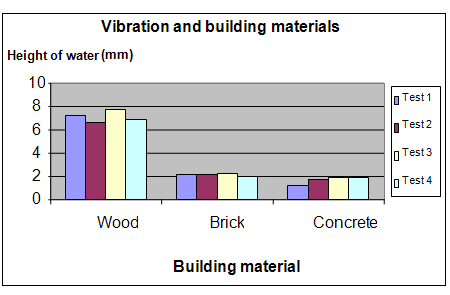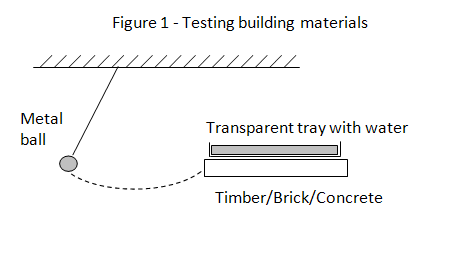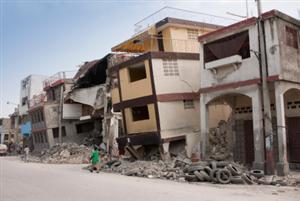| Complexity level: | 6 |
| Project cost ($): | 50 |
| Time required: | 1 hour to prepare, 2 hours for the science project experiment |
| Material availability: | Easily found - you can try Home Depot, or other hardware stores |
| Safety concerns: | Use safety gloves and common sense when handling heavy/hard objects. |
Hypothesis
Timber is suitable for use as a building material, in earthquake prone areas.
Overview
Earthquake and building materials
Common materials used for the construction of houses and buildings are stone, timber, brick and concrete. The choice of materials used in construction may depend on the local weather conditions, material availability, whether the building is located in an earthquake prone zone, and energy efficiency requirements (i.e. to minimize heating or cooling requirements).
Many densely populated cities around the world are now located in earthquake prone areas. The outcome of an earthquake can be very devastating, especially when it occurs in a densely populated city. An earthquake can cause loss of lives, injuries to people, the collapse of buildings, damaged roads and broken pipelines carrying water and flammable/toxic gas.
The use of un-reinforced bricks and concrete as building material in an earthquake prone area is very unwise. Brick and concrete walls are not very strong and will collapse due to the lateral forces during an earthquake. Both bricks and concrete are rigid and brittle, making them crack and break during earthquakes. Wood and steel are more structurally stable during an earthquake. They are both ductile and less likely to collapse during tremors.
Scientific Terms
Materials
The materials required for this science project:
- 1 transparent plastic or glass tray ( at least 50mm in depth)
- Tap water
- 1 spherical metal ball with hook
- 1 meter long string
- 1 concrete slab
- 6 bricks
- 1 piece of timber, about the same size as the concrete slab
- 1 ruler
- 1 small table
Procedure
1. For this experiment, the independent variable is the type of building material used – timber, brick or concrete. The dependent variable is the amount of vibration absorbed by the building material. This is determined by measuring the height of the waves which form inside the tray of water. The constants (control variables) are the size of the tray, the depth of the water, the weight of the ball and the length of the string.
2. The experiment is set up as shown in figure 1 above. The string is used to tie the metal ball and suspend it from the ceiling or from a coat hanger. The suspended metal ball should be able to swing freely as shown.
3. The timber is placed on the small table. The length of the string is adjusted so that when the metal ball swings towards the table, it will knock against the side of the timber as shown in figure 1.
4. The transparent tray is filled with water up to 2 cm deep. The tray is then placed on top of the timber. Once the water is calm and settled, swing the metal ball and allow it to knock against the side of the timber. Observe and record the height of the wave in the water during impact. Repeat the test 4 times and record the results in the table given below.
5. Procedures 3 and 4 are repeated using the bricks and the concrete slab. All the measured results are recorded in the table given below.


Results
It was observed that the impact of the metal ball on the timber wood produced the highest wave in the water compared to the brick and concrete.
|
Test Attempt |
Height of water wave in tray upon impact (mm) |
||
|
Wood |
Brick |
Concrete |
|
|
1 |
7.20 |
2.10 |
1.20 |
|
2 |
6.60 |
2.10 |
1.70 |
|
3 |
7.75 |
2.25 |
1.85 |
|
4 |
6.90 |
2.05 |
1.90 |
The chart below represents the results of our science project experiment:

Conclusion
The hypothesis that timber is suitable for use as building materials in earthquake prone areas, is proven to be true. The wood allowed the vibration from the impact to "pass through" and reach the water tray causing waves in the water. This means that less energy from the impact has been actually absorbed by the wood. Conversely, less vibrations were "passed through" by the brick and concrete - this means that they absorbed more energy from the impact and are hence more vulnerable to damage due the impact.
Most of the devastations to buildings and homes that happen during an earthquake can be reduced by using the proper building material, technique and foundations. Using the correct material can minimize the damage and prevent building collapse during earthquakes. Having proper ground foundation with base isolators can also help buildings to survive an earthquake.
Also consider
Try to repeat the experiment using different materials like steel and reinforced concrete.
The experiment can also be repeated by increasing the weight of the metal ball or adding base isolators under the water tray.
References
And they all fall down – preventing structural damage in earthquakes -http://raebear.net/writings/earthquake.html
The best building material for homes: timber, bricks, concrete or stone - http://hubpages.com/hub/The-Best-Building-Materials-for-Home-Timber--Bricks--Concrete--or-Stone

